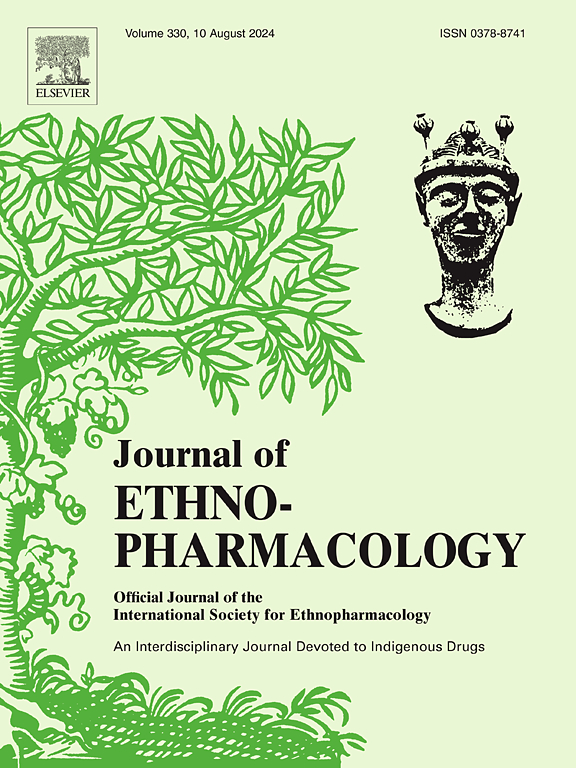Ethyl acetate extract from Herpetospermun cardigerum wall. Ameliorated concanavalin A-induced autoimmune hepatitis in mice by reprofiling gut microenvironment to modulate IDO1/KYN and PI3K/AKT/NF-κB pathways
IF 4.8
2区 医学
Q1 CHEMISTRY, MEDICINAL
引用次数: 0
Abstract
Background
Autoimmune hepatitis (AIH) is an immunoinflammatory chronic liver disease with increasing prevalence worldwidely, lacking of effective medicine. Herpetospermum caudigerum Wall. (HC) is a traditional Tibetan medicine used to treat liver diseases for thousands of years. However, investigation into the effects of HC in AIH remains scarce.
Purpose
Our study aimed to explore the effects and mechanisms of ethyl acetate extract from the seeds of HC (HCDEAE) against concanavalin A (Con A)-induced liver impairment in mouse.
Study design and methods
HCDEAE was extracted from the seeds of HC, then characterized by UPLC-Q-TOF/MS. Con A-induced AIH mice were used to investigate the impacts of HCDEAE on liver impairment, T cells differentiation, gut microbiota and its derived metabolites, intestinal barrier impairment and inflammation, as well as the mechanisms of HCDEAE in liver in AIH.
Results
HCDEAE (90 mg/kg, i.g.) effectively alleviated Con A-induced hepatic pathological damage, suppressed elevation of serum ALT, AST, IFN-γ, and TNF-α; in spleen, HCDEAE attenuated spleen impairment, elevated the percentage of CD4+CD25+ cells and FOXP3 gene expression, inhibited up-regulation of RORγt gene expression and IL-17; in liver, HCDEAE down-regulated IL-17, elevated FOXP3 gene expression and IL-10, increased the protein and gene expression of TGF-β1; in colon, HCDEAE attenuated intestinal barrier impairment, inhibited down-regulation of Occludin and ZO-1, and relieved elevation of IL-1β, as well as re-profiled the gut microenvironment. Furthermore, HCDEAE demonstrated the ability to elevate tryptophan metabolism among kynurenine pathway, activate IDO1/KYN pathway and inhibit PI3K/AKT/NF-κB signaling pathway in liver of AIH mice.
Conclusion
Pretreatment with HCDEAE (90 mg/kg·d−1, i.g.) for 9 days could effectively alleviate the liver inflammation and injure, protect intestinal barriers, attenuate spleen impairment, maintain Treg-Th17 cell equilibrium in Con A-induced AIH mice, via re-profiling gut microbiota, modulation of tryptophan metabolism in the gastrointestinal tract and in liver, to activate IDO1/KYN pathway and inhibit the abnormal activation of PI3K/AKT/NF-κB signaling pathway in liver. The present study highlighted the potential of HCDEAE as a drug candidate for AIH.

求助全文
约1分钟内获得全文
求助全文
来源期刊

Journal of ethnopharmacology
医学-全科医学与补充医学
CiteScore
10.30
自引率
5.60%
发文量
967
审稿时长
77 days
期刊介绍:
The Journal of Ethnopharmacology is dedicated to the exchange of information and understandings about people''s use of plants, fungi, animals, microorganisms and minerals and their biological and pharmacological effects based on the principles established through international conventions. Early people confronted with illness and disease, discovered a wealth of useful therapeutic agents in the plant and animal kingdoms. The empirical knowledge of these medicinal substances and their toxic potential was passed on by oral tradition and sometimes recorded in herbals and other texts on materia medica. Many valuable drugs of today (e.g., atropine, ephedrine, tubocurarine, digoxin, reserpine) came into use through the study of indigenous remedies. Chemists continue to use plant-derived drugs (e.g., morphine, taxol, physostigmine, quinidine, emetine) as prototypes in their attempts to develop more effective and less toxic medicinals.
 求助内容:
求助内容: 应助结果提醒方式:
应助结果提醒方式:


